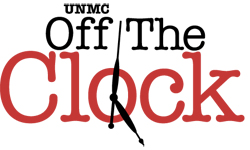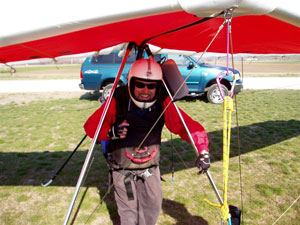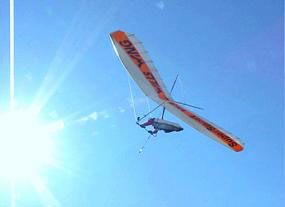 Look!
Look!
Up in the sky!
Is it a bird? Is it a plane?
Nope.
It’s Michael Boska, Ph.D., professor and vice chairman of research in the UNMC Radiology Department, hang gliding over his acreage in Glenwood, Iowa.
 |
As a departure from his cerebral job as a scientist, Michael Boska, Ph.D., heads to the skys to partake in his hobby, hang gliding. |
Upon taking up the sport in 1982 while a graduate student at the University of California-Berkley, Dr. Boska found the experience lived up to his expectations.
“I find flying relaxing, yet physically demanding,” he said. “It is an excellent mental counterpoint to my otherwise highly cerebral existence as a scientist. When you are flying, you simply feel and react, you do not analyze. In addition, it’s really fun!”
He since has participated in his high-flying hobby in several states including California, Wyoming, Idaho, Utah, Tennessee, Florida, Michigan, Ohio, Nebraska, Nevada, New York and Iowa.
He also has flown hang gliders in Norway, a trip he documented in a 1992 edition of Hang Gliding magazine, which is now called Hang Gliding and Paragliding.
The hang glider is controlled by the pilot’s body motions. While no formal training is required for hang gliding (it is strongly suggested), glider pilots do go through a licensing process that involves written and flying tests.
All developed flying sites require pilots to have licenses.
“The license provides liability insurance to the site in case of accidents,” Dr. Boska said, “and history demonstrates that properly rated pilots rarely have accidents, minimizing the problems with keeping a site open.”
Hang gliders range in price from $1,000 to $10,000.
Costs of other required equipment include harnesses, which range in price from $100 to $600, helmets ($50 to $300) and parachutes ($200 to $400).
Pilots can keep costs down by using minimal equipment and only jump from free launching pads.
“The purchase of equipment can be expensive depending on your level and tendency to want more toys,” Dr. Boska said.
To participate in his hobby in the Midwest, which lacks the high peaks and cliffs hang gliders enjoy in mountainous areas, Dr. Boska has attached a 14 horsepower motor to his glider.
Although this allows him to fly his glider to almost 18,000 feet in unrestricted airspace, he typically he shuts his motor off after climbing to 2,000 to 3,000 feet and rides to wind currents to keep aloft.
 |
While soaring thousands of feet in the air, Dr. Boska sometimes enjoys the company of eagles, hawks and other high-flying creatures. |
“There is nothing like the thrill of a good mountain or cliff launch,” Dr. Boska said. “However, once you get up with a motor, you can shut it down and soar so it is a viable alternative.”
Time and weather constraints allow Dr. Boska to fly about once a month.
It’s then that he enjoys incredible panoramic views as well as the company of eagles and hawks.
“They are very curious and will come right up and fly with you if you during unpowered flights,” Dr. Boska said of the birds.
Q & A
What does hang gliding feel like?
In smooth air, it feels floaty and fluid — a lot like flying in a dream, except its real. In rough air, it can be scary to be fighting for control of the glider against the turbulence.
Tell us about a scary moment you had in the air?
There was one in particular in the Owens Valley (Calif.) cruising the east side of the Sierra Nevada Mountains past Mount Whitney. I was flying and was hit by a small but extremely powerful thermal (a column of warm air that occurs when the sun heats air, causing it to rise), which lifted the nose of the glider so hard that I could not pull it down. Just as violently, I was spit out of the other end of the thermal — an experience known to hang glider pilots as “going over the falls” — and was looking down at the glider for a few seconds wondering if it was going to tumble and if I would need to throw my emergency parachute. The glider did not tumble and I decided there and then to land. My fun meter was pegged for that day.
What’s been your best experience hang gliding?
There are so many — looking down on Lake Tahoe from 16,000 feet, flying with other gliders, sailplanes and birds in a flock, the thrill of stepping off of a 3,000-foot cliff in Yosemite National Park (known as Glacier Point). However, the experiences that particularly stay with me are the times I get to fly with eagles and Red Tailed Hawks.
Where is your favorite place to fly?
My favorite place to fly is Hull Mountain, which is in the coastal range of California. It is a 5,000-foot high launch near Ukiah, Calif., which is about two hours north of San Francisco. It is a great place to fly, offers breathtaking views, and at the end of the day, Lake Pillsbury, which is next to the landing zone, is great for swimming or other water recreation.
What attracted you to the sport in the first place?
I had childhood dreams of flying including the ideas of ballooning and parachuting. When I heard about hang gliding, it became the new dream. Now I live the dream and it is good.
How would someone go about getting started?
Unfortunately, there is no school in this region, however all of the rated schools can be found at the USHPA Web site under “where to learn.”